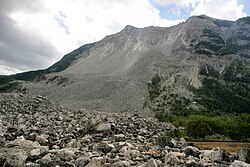

The examples and perspective in this article deal primarily with North America and Europe and do not represent a worldwide view of the subject.(January 2025) |


A geomorphosite, or geomorphological heritage site, is a landform or an assemblage of landforms that have a scientific, educational, historic-cultural, aesthetic or socio-economic value. [3] [4]

Geomorphosites are included among the geoheritage sites (geosites) and may comprise landforms (or sites of former landforms) that have been hidden or destroyed due to human activities, [6] [7] as well as anthropogenic landforms [8] [9] of archaeological or historical interest. [10]

The value of a geomorphosite, for purposes of analysis, comparison and protection, can be qualitatively assessed using several methods. [11] Some of these methods are based only on expert judgements and a few evaluation criteria, while others involve assigning a qualitative score to each relevant characteristic of a site (e.g. its scientific importance, educational value etc.) and then weighting and summing (or ranking) the scores to obtain the site's overall value (or rank).
The concept of geomorphosite has its roots in Western scientific thought. In recent decades, natural heritage conservation has increasingly focused on preserving representative examples of specific natural phenomena. [12] This shift aligns with the growing influence of scientific approaches and economic rationalism, which often prioritize objective, data-driven arguments over those perceived as emotional or subjective. However, this representative methodology may not be suitable, for instance, for sites considered sacred by faith communities, as these locations are unique and hold profound spiritual significance that transcends scientific categorization. [12] A solution to this problem may be to consider multiple value dimensions of a geomorphosite and to include into the evaluation process the interested stakeholders and right holders (e.g. indigenous communities), which also ensures a greater degree of objectivity in the evaluation itself. [13]

